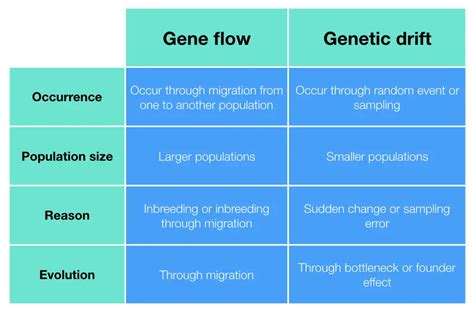Introduction
Genetic flow and drift are two fundamental processes that influence the genetic makeup of populations. Understanding their mechanisms and relative contributions is crucial for comprehending how populations adapt, evolve, and respond to environmental changes. In this article, we will delve into these concepts, exploring their implications for population genetics and conservation biology.

Genetic Flow
Definition:
Genetic flow refers to the movement of genes into or out of a population through various mechanisms, such as migration, gene flow, and hybridization.
Mechanisms of Genetic Flow:
- Migration: Individuals move from one population to another, introducing new alleles and altering the genetic composition of both populations.
- Gene Flow: Genes can be exchanged between populations through the movement of gametes (e.g., pollen, sperm).
Effects of Genetic Flow:
- Increases genetic diversity within populations, reducing the risk of inbreeding and genetic disorders.
- Introduces new genetic traits into populations, enhancing adaptive potential and resilience.
- Homogenizes genetic variation across populations, reducing genetic differentiation.
Examples:
- Migratory bird species transferring genes between breeding and wintering grounds.
- Movement of pollen between neighboring plant populations.
Genetic Drift
Definition:
Genetic drift is the random change in allele frequencies within a population, primarily due to chance events. It occurs when a small number of individuals contribute to the next generation.
Causes of Genetic Drift:
- Population Bottlenecks: Sudden reductions in population size due to natural disasters, habitat loss, or founder effects.
- Sampling Error: Random fluctuations in allele frequencies during reproduction.
Effects of Genetic Drift:
- Can lead to the loss of genetic variation, especially in small populations.
- May result in fixation of certain alleles, increasing homozygosity and potentially harmful genetic mutations.
- Can hinder adaptation and increase susceptibility to environmental stressors.
Examples:
- Small, isolated populations of endangered species facing genetic drift.
- Populations recovering from population bottlenecks, such as after a wildfire.
Comparison of Genetic Flow and Drift
| Feature | Genetic Flow | Genetic Drift |
|---|---|---|
| Mechanism | Movement of genes between populations | Random allele frequency changes |
| Cause | Migration, gene flow | Population bottlenecks, sampling error |
| Effects | Increases genetic diversity | Reduces genetic diversity |
| Impact | Reduces genetic differentiation | Increases genetic differentiation |
| Importance | Maintains gene flow and diversity | May lead to loss of gene flow and genetic variation |
Implications for Conservation Biology
Understanding the relative roles of genetic flow and drift is critical for conservation strategies.
- Conservation of Genetic Diversity: Maintaining genetic flow through habitat connectivity and translocations can prevent genetic drift and preserve genetic diversity.
- Population Viability: Small, isolated populations are more susceptible to genetic drift, which can reduce their adaptive potential and increase their extinction risk.
- Recovering Threatened Species: Genetic rescue programs can introduce new genetic material to populations facing genetic drift, increasing their diversity and resilience.
Novel Applications
Population Genomics: Advancements in DNA sequencing technologies have enabled population genomics studies, which provide insights into genetic flow and drift patterns across large populations.
Conservation Genetics: Using genetic flow and drift data, researchers can identify high-priority conservation areas and develop strategies to maintain genetic connectivity and prevent inbreeding.
Climate Change Adaptation: Understanding how genetic flow and drift influence adaptation to changing environmental conditions can help predict and mitigate future impacts on species.
Conclusion
Genetic flow and drift are fundamental processes that shape the genetic makeup of populations. Genetic flow maintains gene flow and diversity, while drift can lead to its loss. Understanding these processes is essential for population genetics, conservation biology, and advancing our knowledge of how organisms evolve and adapt to their environment. By harnessing genetic flow and mitigating the effects of drift, we can conserve genetic diversity and promote species resilience in the face of global challenges.
